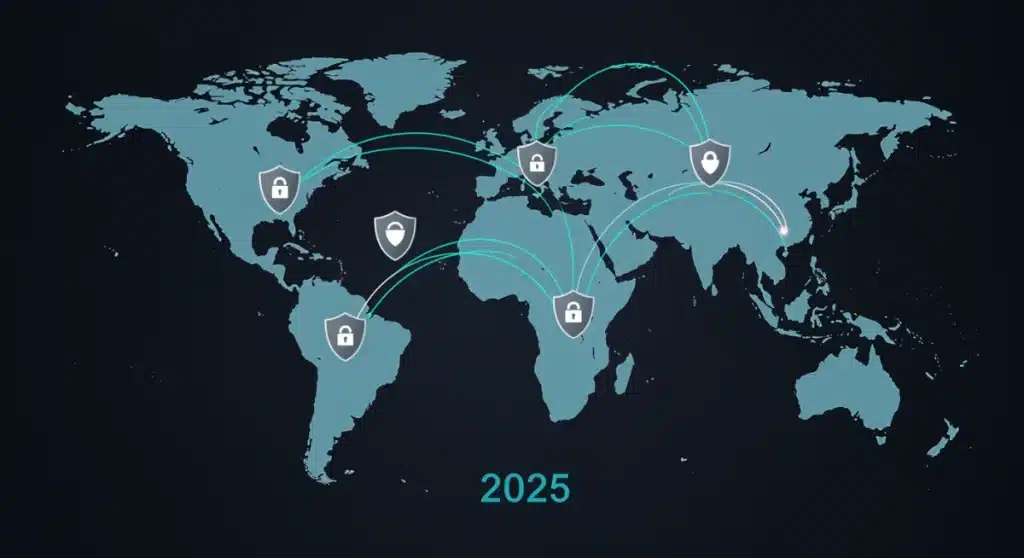Ensuring Global Network Resiliency: 2025 DR Blueprint for US Corps

US corporations are actively seeking to bolster their global network resiliency, a critical undertaking for 2025. This blueprint outlines practical, proactive disaster recovery strategies to safeguard international operations against escalating digital and physical threats.
As of today, US corporations face an increasingly complex landscape, making global network resiliency paramount. With the digital frontier expanding and threats evolving, a robust disaster recovery blueprint for 2025 is not just advisable, but essential for maintaining operational continuity and competitive advantage worldwide.
Understanding the Evolving Threat Landscape for Global Networks
The current global environment presents unprecedented challenges to network stability. From sophisticated cyberattacks to geopolitical instabilities and natural disasters, the vectors of disruption are numerous and varied. US corporations operating internationally must acknowledge this shift and adapt their strategies accordingly.
Recent reports indicate a surge in state-sponsored cyber espionage and ransomware attacks targeting critical infrastructure and multinational enterprises. This evolving threat landscape necessitates a proactive and adaptive approach to network security and disaster preparedness, moving beyond traditional perimeter defenses.
Cybersecurity Threats on the Rise
Cyber threats are no longer isolated incidents but orchestrated campaigns designed to inflict maximum damage. Organizations must contend with:
- Advanced Persistent Threats (APTs) that evade standard detection.
- Ransomware attacks crippling operations and demanding hefty payments.
- Supply chain vulnerabilities exploited to gain access to core systems.
Geopolitical and Environmental Risks
Beyond digital threats, physical and geopolitical factors significantly impact network resiliency. These include:
- Political instability in key operational regions leading to service disruptions.
- Natural disasters, such as earthquakes or hurricanes, damaging physical infrastructure.
- Infrastructure sabotage targeting undersea cables or data centers.
Key Pillars of a 2025 Disaster Recovery Blueprint
A comprehensive disaster recovery blueprint for global networks in 2025 must be built upon several foundational pillars. These elements collectively ensure that US corporations can withstand and rapidly recover from any significant disruption, maintaining business continuity across their international footprint.
Effective planning involves not just technological solutions but also robust organizational processes and skilled personnel. Integrating these pillars creates a holistic defense against the unpredictable nature of global network failures and security breaches.
Multi-Cloud and Hybrid Cloud Strategies
Leveraging diverse cloud environments mitigates single points of failure. A multi-cloud approach ensures that if one provider or region experiences an outage, operations can seamlessly failover to another. Hybrid cloud models offer flexibility, balancing on-premise control with cloud scalability.
This strategy also allows for geographical distribution of data and applications, significantly reducing the impact of localized disasters. Companies are increasingly adopting frameworks that enable workload portability across different cloud platforms, enhancing their disaster recovery capabilities.
Automated Recovery and Orchestration
Manual recovery processes are often too slow and prone to human error in critical situations. Automation is key to achieving rapid and reliable disaster recovery. Orchestration tools can automate the failover and failback of applications and data, ensuring minimal downtime.
These systems can automatically detect outages, initiate recovery procedures, and validate the integrity of restored services. This reduces recovery time objectives (RTOs) and recovery point objectives (RPOs), which are crucial metrics for business continuity.
Implementing Proactive Monitoring and Threat Intelligence
Proactive monitoring and robust threat intelligence are indispensable components of a modern disaster recovery strategy. For US corporations operating globally, understanding potential threats before they materialize can mean the difference between minor disruptions and catastrophic failures.
Continuous surveillance of network health, coupled with real-time threat feeds, enables organizations to anticipate and react swiftly to emerging risks. This predictive capability is vital in an environment where attack methods are constantly evolving.
Real-time Network Monitoring
Deploying advanced network monitoring tools provides immediate visibility into network performance and security events. These tools can detect anomalies, identify potential breaches, and alert security teams instantly, allowing for rapid containment and mitigation.
Key aspects of real-time monitoring include:
- Packet inspection and traffic analysis for suspicious patterns.
- Endpoint detection and response (EDR) solutions for device-level security.
- Security Information and Event Management (SIEM) systems for centralized logging and analysis.
Leveraging Global Threat Intelligence
Access to up-to-date global threat intelligence is critical for understanding the adversary. This includes information on new attack vectors, vulnerabilities, and the tactics, techniques, and procedures (TTPs) of threat actors.
Corporations should integrate threat intelligence feeds into their security operations centers (SOCs) to enrich their detection capabilities and inform their defensive strategies. Sharing intelligence within industry groups also strengthens collective defense.

Data Redundancy and Geographic Distribution Strategies
Data is the lifeblood of any modern corporation, and its protection is central to global network resiliency. Robust data redundancy and strategic geographic distribution are non-negotiable for US corporations aiming to maintain operations despite localized disruptions.
These strategies ensure that critical data remains accessible and intact, even if primary systems are compromised or physically damaged. Diversifying data storage locations minimizes the impact of regional outages or targeted attacks.
Distributed Data Centers and Storage
Establishing data centers and storage facilities in multiple, geographically dispersed locations is a cornerstone of effective disaster recovery. This approach ensures that if one site becomes unavailable, another can seamlessly take over, providing continuous access to data and applications.
This distribution should consider geopolitical risks, natural disaster zones, and regulatory compliance requirements. The goal is to create a resilient architecture where no single point of failure can bring down the entire system.
Regular Backup and Replication
Consistent data backup and replication are fundamental. Data should be backed up frequently, and these backups should be stored both locally and off-site. Replication, especially synchronous or asynchronous replication across different regions, ensures that data is always up-to-date and recoverable.
Testing these backup and replication processes regularly is crucial to confirm their effectiveness. An untested backup is a risk, as recovery procedures can fail if not properly validated under simulated disaster conditions.
Building a Resilient Global Supply Chain for IT Infrastructure
The integrity of the IT supply chain is increasingly a focus point for global network resiliency. For US corporations, ensuring that hardware, software, and services procured globally are secure and reliable is a complex but vital task. A compromised supply chain can introduce vulnerabilities that undermine even the most robust disaster recovery plans.
This involves rigorous vetting of vendors, establishing clear security requirements, and continuously monitoring for potential risks throughout the entire lifecycle of IT components and services. The interconnected nature of modern supply chains means a weakness in one link can affect the entire chain.
Vendor Risk Management
Thorough vendor risk management is essential. Corporations must assess the security posture of all third-party suppliers, particularly those providing critical network infrastructure or software. This includes evaluating their cybersecurity practices, compliance with international standards, and their own disaster recovery capabilities.
Establishing clear contractual agreements that mandate security controls and incident reporting is also key. Regular audits and assessments of vendor environments help maintain compliance and identify potential weaknesses before they are exploited.
Diversifying Suppliers and Geographies
Relying on a single vendor or a limited geographic region for critical IT components introduces significant risk. Diversifying suppliers and sourcing from multiple regions can mitigate the impact of disruptions, whether caused by geopolitical tensions, natural disasters, or vendor-specific issues.
This strategy enhances resilience by providing alternative sources for essential hardware and software, preventing bottlenecks and ensuring continuity of supply even in challenging circumstances. It also reduces exposure to country-specific regulatory or political risks.
Developing and Testing Incident Response Plans
Even with the most robust preventative measures, incidents will occur. Therefore, having well-defined, regularly tested incident response plans is non-negotiable for maintaining global network resiliency. For US corporations, these plans must account for the complexities of international operations, diverse regulatory environments, and multi-cultural communication challenges.
An effective incident response plan minimizes the impact of an event, restores services quickly, and helps prevent future occurrences. It’s a dynamic document that evolves with the threat landscape and organizational changes.
Comprehensive Incident Response Frameworks
A comprehensive framework outlines the roles, responsibilities, and procedures for responding to various types of incidents. This includes:
- Identification and containment of the incident.
- Eradication of the threat and recovery of affected systems.
- Post-incident analysis and lessons learned.
The framework should be adaptable to different severity levels and types of incidents, from minor service disruptions to major cyberattacks affecting multiple global regions. Clear communication protocols are also vital, both internally and with external stakeholders.
Regular Drills and Tabletop Exercises
An incident response plan is only as good as its last test. Regular drills and tabletop exercises are crucial for ensuring that teams are prepared to execute the plan effectively under pressure. These simulations help identify weaknesses in the plan, clarify roles, and improve coordination across different departments and international offices.
Exercises should simulate realistic scenarios, including cyberattacks, natural disasters, and geopolitical events. The feedback from these drills should be used to refine and update the incident response plan continuously, making it a living document.
The Role of Regulatory Compliance and International Standards
For US corporations operating globally, adherence to regulatory compliance and international standards is not merely a legal obligation but a critical component of global network resiliency. Non-compliance can lead to significant fines, reputational damage, and operational restrictions, all of which hinder effective disaster recovery and business continuity.
Integrating compliance requirements into the disaster recovery blueprint ensures that data handling, security protocols, and operational procedures meet global benchmarks, thereby strengthening the overall resilience posture.
Navigating Global Data Privacy Regulations
Data privacy regulations such as GDPR, CCPA, and numerous country-specific laws impose strict requirements on how personal data is collected, stored, processed, and transferred across borders. A disaster recovery plan must ensure that these regulations are upheld even during a crisis event.
This includes provisions for secure data restoration, notification procedures for data breaches, and maintaining data sovereignty where applicable. Failure to comply can result in severe penalties and erode customer trust.
Adherence to ISO and NIST Frameworks
International standards like ISO 27001 (Information Security Management) and NIST Cybersecurity Framework provide a structured approach to managing cybersecurity risks and building resilient systems. Adhering to these frameworks demonstrates a commitment to best practices and provides a robust foundation for disaster recovery planning.
These standards guide organizations in establishing comprehensive security controls, conducting risk assessments, and developing incident response capabilities that are recognized globally. This helps streamline compliance efforts across different jurisdictions and enhances overall network resilience.
| Key Point | Brief Description |
|---|---|
| Evolving Threats | Cyberattacks, geopolitical instability, and natural disasters increasingly disrupt global networks. |
| Multi-Cloud Strategy | Distributing data and applications across diverse cloud environments minimizes single points of failure. |
| Proactive Monitoring | Real-time network surveillance and global threat intelligence enable rapid incident anticipation and response. |
| Incident Response Testing | Regular drills and tabletop exercises are crucial for validating and refining disaster recovery plans. |
Frequently Asked Questions
Global network resiliency refers to an organization’s ability to maintain continuous network operations and data accessibility despite disruptions like cyberattacks, natural disasters, or geopolitical events, especially across international infrastructures. It ensures business continuity and minimizes downtime.
A 2025 blueprint is crucial due to the escalating complexity of cyber threats, increasing geopolitical instability, and the interconnectedness of global operations. It provides a structured, proactive approach to safeguard international assets and ensure compliance with evolving regulations, protecting against significant financial and reputational damage.
Multi-cloud strategies enhance resiliency by distributing data and applications across different cloud providers and geographical regions. This approach mitigates single points of failure, ensures that operations can failover seamlessly if one cloud service or region experiences an outage, and improves data availability.
Threat intelligence provides up-to-date information on emerging cyber threats, vulnerabilities, and attacker tactics. Integrating this intelligence into disaster recovery planning allows corporations to anticipate potential attacks, strengthen their defenses proactively, and refine incident response procedures to effectively counter specific, evolving threats.
Regular testing, through drills and tabletop exercises, is vital because it validates the effectiveness of incident response plans. It helps identify weaknesses, clarifies roles and responsibilities, and improves coordination among teams. Untested plans can fail under pressure, leading to prolonged downtime and greater impact.
Looking Ahead
The imperative for US corporations to strengthen their global network resiliency will only intensify in the coming years. As digital transformation accelerates and global dependencies deepen, the strategies outlined in this 2025 blueprint will serve as a foundational guide. Organizations that proactively invest in these practical solutions—from multi-cloud architectures to rigorous incident response testing—will be better positioned to navigate future disruptions. The focus now shifts to continuous adaptation and innovation, ensuring that global operations remain secure, stable, and resilient against any unforeseen challenge.





